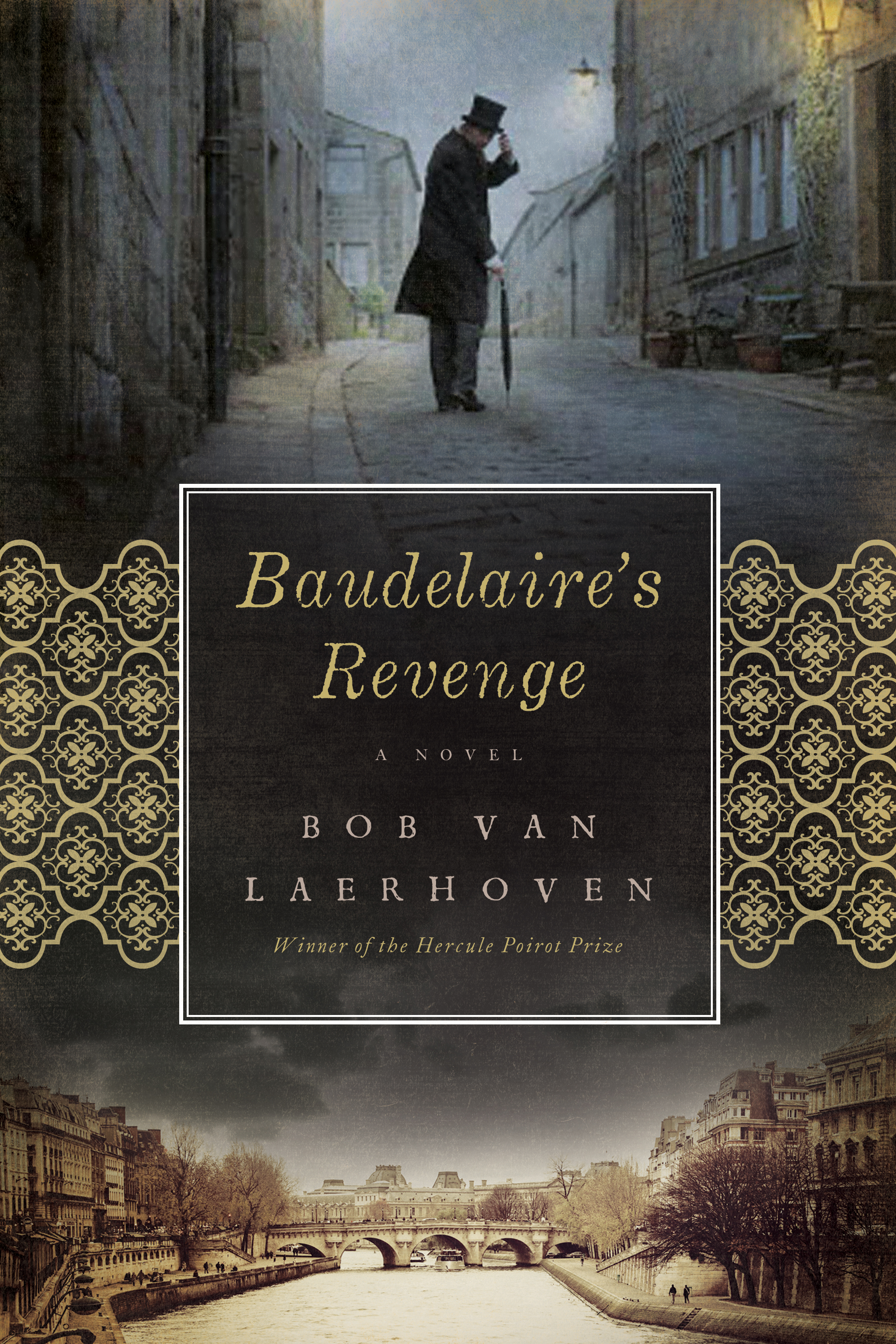SYPHILIS: THE AIDS OF THE 19TH CENTURY by Bob Van Laerhoven
When first the original Dutch edition, followed by the French translation, of Baudelaire’s Revenge – De wraak van Baudelaire - La Vengeance de Baudelaire –– appeared in Belgium, the Netherlands, France and Canada, many readers were speculating on the novel’s surprising end: Is it “esoteric” or not?The same goes for the English translation – Baudelaire’s Revenge – published this year in the US by Pegasus Books.
Without giving away the answer – that would be foolish of me after all my hard work, now, wouldn’t it? – I advise readers to take a short moment to ponder the title of the book. “Baudelaire’s Revenge” was not chosen because the title makes you think it’s a crime novel, but because of its subtle meaning.
How can the world famous French poet Charles Baudelaire who has been dead for three years at the start of the novel, take revenge? The answer lurks in the “AIDS of the 19th century”: syphilis, also known as French pox, the clap, tropical bubo, morbus Gallicus (“the French disease”), hard chancre… etc..
In the 19th century syphilis was considered a scourge of the mighty, the rich… and the artists. Many novels and plays presented the disease as an essential plot point. There was a wealth of famous names linked to the topic that could be of literary use: Cesare Borgia, Henry VIII, Ivan the Terrible, John Keats, even Napoleon Bonaparte, were known to have suffered from syphilis.
Anthony Burgess and other present-day authors have noted Shakespeare’s obsession with syphilis: the Divine Bard possessed clinically exact knowledge of its manifestations, which surfaced in many of his sonnets. Guy de Maupassant, “the inspired madman,” complained to his colleague Flaubert about his “darkest depressions and infinite disease.” De Maupassant’s syphilis led him to write horror stories like The Horla, in which the last stage of neurosyphilis was symbolized in the form of a Demon invading the protagonist’s brain. In everyday life, de Maupassant became obsessed with the idea that flies were eating his brain and he suffered “hellish” hallucinations. The brilliant short-story writer died in an asylum, his mind destroyed by the venereal disease.
As recently as the beginning of the 20th century, syphilis was considered to be inherited rather than contagious. Many physicians were convinced that it was transmitted by “women of the working class” as well as by prostitutes, because syphilis was thought to be hereditary in those humble social classes. The “clap” thus became a tool in a conflict of classes: women of the poor quartiers and cocottes were blamed with undermining the social order by “degenerating” families of the higher classes - whose men they seduced - through the disease.
Between 1870 and 1900, French women who were suspected of having syphilis were therefore arrested and imprisoned in dreadful circumstances. As a result, many prostitutes tried to hide their genital lesions with special ointments and skin-colored creams, as described in Baudelaire’s Revenge.
There was not much that medicine could do for sufferers but administering mercury, which was horribly toxic and of doubtful efficiency. Despite the relentless spreading of the disease through direct contact with the genital sores, most physicians considered condom use futile and even a possible source of “mental decay” in women who enjoyed “useless orgasms” because they knew that the condom would prevent pregnancy. So “the Great Pretender”, as the “morbus Gallicus” was sometimes called due to the efforts of the sufferers to hide it, could go on wreaking havoc.
Syphilis is caused by the bacterium Treponema pallidum, first discovered in 1905, that can be transmitted to unborn children in the womb. In the 19th century, around 70% of the newborns infected with this congenital form died. If they survived, they bore a terrible burden, manifested by blindness, nose deformations, notched teeth, and mental retardation.
In adults, the disease revealed itself in three stages: primary syphilis was no more than a painless initial sore, the secondary stage threw in a rash and fever. The third stage could follow after many years of latency and took on different forms. Gummatous syphilis is characterized by granulomatous lesions. These “gummas,” as they are called, have a rubbery texture and invade skin and organs. Most sufferers of this form lost their noses. Cardiovascular syphilis began as an inflammation of the arteries and could be life-threatening by damaging the heart valves or rupturing blood vessels. Neurosyphilis, the syphilitic infection of the nervous system, is the most chronic and insidious inflammatory process known. Psychosis, delirium, and dementia were the result. In the late stage of this form of syphilis, sufferers very often experienced brusque and absurd delusions, included sensations of immortality, supernatural powers, apocalyptic visions, or being harassed by “entities,” demons or devils.
Now imagine this: in Baudelaire’s Revenge, in 1870, commissioner Paul Lefèvre is prowling the Parisian streets in uproar. His mind is in turmoil. He has just killed the woman he loved. He feels a dreadful fever invading his body. The Communards, members of the workers’ association that instigated the uprising, are being slaughtered by the National Guard. France is no longer at war with the Prussians but with itself.
As is Paul Lefèvre. Beads of sweat roll down his heavy jowls. He wonders: Is the world a stage, an illusion?
Am I one?
Penicillin, the antibiotic that cures syphilis, was discovered in 1928. It would take until 1943 until it was first used in this indication.
About the Book
Publication Date: April 15, 2014 | Pegasus Books | Formats: eBook, Hardcover
Genre: Historical Mystery/Thriller
It is 1870, and Paris is in turmoil.
As the social and political turbulence of the Franco-Prussian War roils the city, workers starve to death while aristocrats seek refuge in orgies and seances. The Parisians are trapped like rats in their beautiful city but a series of gruesome murders captures their fascination and distracts them from the realities of war. The killer leaves lines from the recently deceased Charles Baudelaire's controversial anthology Les Fleurs du Mal on each corpse, written in the poet's exact handwriting. Commissioner Lefevre, a lover of poetry and a veteran of the Algerian war, is on the case, and his investigation is a thrilling, intoxicating journey into the sinister side of human nature, bringing to mind the brooding and tense atmosphere of Patrick Susskind's Perfume. Did Baudelaire rise from the grave? Did he truly die in the first place? The plot dramatically appears to extend as far as the court of the Emperor Napoleon III.
A vivid, intelligent, and intense historical crime novel that offers up some shocking revelations about sexual mores in 19th century France, this superb mystery illuminates the shadow life of one of the greatest names in poetry.
Praise for Baudelaire's Revenge
“[An] intense historical crime thriller. The intricate plot, menacing atmosphere, and rich evocations of period Paris have undeniable power.” (Publishers Weekly)“Vigorous. A finely-tuned balancing act between style and content. Add to all this the extremely convincingly painted tragic characters and the multitude of mysterious figures, and what you get is a winner who gives added luster to this jubilee edition of the Hercule Poirot Prize.” (The jury of the Hercule Poirot Prize)
"Van Laerhoven packs much complexity into 256 pages, giving this historical mystery the heft of a far longer work ( …) The book’s main preoccupation is the conclusive demonstration that everyone is guilty of something—the only mystery is, to what degree? The flowers of evil, sketched in lurid botanical detail..." (Kirkus Reviews)
“(A) decadent tale….Commissioner Lefèvre’s philosophical discussions with artists and poets and a creepy Belgian dwarf are fascinating….” (NY Times Book Review)
"Published for the first time in English, this roman policier isn't so much a straight detective story (although there are two detectives in it) as an evocation of a mind-set that now seems extravagant: the 19th-century poet's fascination with sex and death. It's no wonder this title won the Hercule Poirot Prize: the author is Belgian, as is the prize, and the twisted plot is as complicated as Agatha Christie's most convoluted mystery. Mystery aficionados will love this pastiche of Wilkie Collins and Edgar Allan Poe." (Library Journal)
“(A) gritty, detail-rich historical mystery novel involves the reader in a subtle narrative web. This complex mystery from an award-winning Belgian author joins history and literary history to create a sly, smart revenge tale.” (Shelf Awareness Pro)
Watch the Book Trailer
Buy the Book
AmazonBarnes & Noble (Hardcover)
Barnes & Noble (Nook)
IndieBound
About the Author
 Bob Van Laerhoven became a full-time author in 1991 and has written more than thirty books in Holland and Belgium. The context of his stories isn’t invented behind his desk, rather it is rooted in personal experience. As a freelance travel writer, for example, he explored conflicts and trouble-spots across the globe from the early 1990s to 2005. Echoes of his experiences on the road also trickle through in his novels. Somalia, Liberia, Sudan, Gaza, Iran, Iraq, Myanmar… to name but a few.
Bob Van Laerhoven became a full-time author in 1991 and has written more than thirty books in Holland and Belgium. The context of his stories isn’t invented behind his desk, rather it is rooted in personal experience. As a freelance travel writer, for example, he explored conflicts and trouble-spots across the globe from the early 1990s to 2005. Echoes of his experiences on the road also trickle through in his novels. Somalia, Liberia, Sudan, Gaza, Iran, Iraq, Myanmar… to name but a few.During the Bosnian war, Van Laerhoven spent part of 1992 in the besieged city of Sarajevo. Three years later he was working for MSF - Doctors without frontiers - in the Bosnian city of Tuzla during the NATO bombings. At that moment the refugees arrived from the Muslim enclave of Srebrenica. Van Laerhoven was the first writer from the Low Countries to be given the chance to speak to the refugees. His conversations resulted in a travel book: Srebrenica. Getuigen van massamoord – Srebrenica. Testimony to a Mass Murder. The book denounces the rape and torture of the Muslim population of this Bosnian-Serbian enclave and is based on first-hand testimonies. He also concludes that mass murders took place, an idea that was questioned at the time but later proven accurate.
All these experiences contribute to Bob Van Laerhoven’s rich and commendable oeuvre, an oeuvre that typifies him as the versatile author of novels, travel stories, books for young adults, theatre pieces, biographies, poetry, non-fiction, letters, columns, articles... He is also a prize-winning author: in 2007 he won the Hercule Poirot Prize for best thriller of the year with his novel De Wraak van Baudelaire – Baudelaire’s Revenge.
For more information please visit Bob Van Laerhoven's website. You can also connect with him on Facebook and Twitter.
Baudelaire's Revenge Blog Tour Schedule
Monday, October 6Review at Just One More Chapter
Wednesday, October 8
Spotlight & Giveaway at Passages to the Past
Saturday, October 11
Guest Post at The True Book Addict
Monday, October 13
Review at Svetlana's Reads and Views
Tuesday, October 14
Spotlight & Giveaway at Booklover Book Reviews
Wednesday, October 15
Guest Post at The Writing Desk
Thursday, October 16
Review at Shelly's Book Shelves
Friday, October 17
Spotlight at CelticLady's Reviews
Saturday, October 18
Review at With Her Nose Stick in a Book
Monday, October 20
Review at Carpe Librum
Tuesday, October 21
Spotlight at Broken Teepee
Wednesday, October 22
Spotlight & Giveaway at Peeking Between the Pages
Thursday, October 23
Review at Bookish
Review at Boom Baby Reviews
Friday, October 24
Spotlight at Historical Tapestry
Guest Post & Giveaway at Bookish

















Found the synopsis of the novel very interesting. Would like to read it.
ReplyDeleteWhat a scary time in which to be living with diseases running rife and no real cures. Thanks for sharing the research behind the book.
ReplyDeleteI really enjoyed this guest post, and am reading the novel as we speak :-)
ReplyDelete